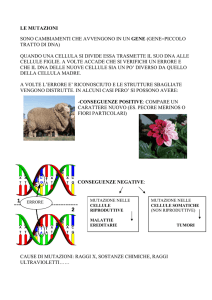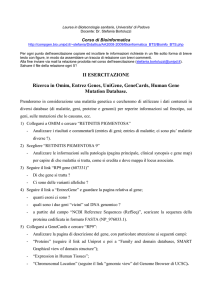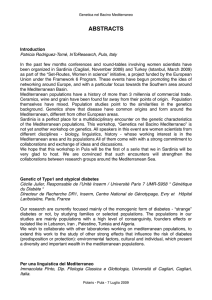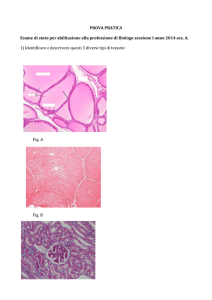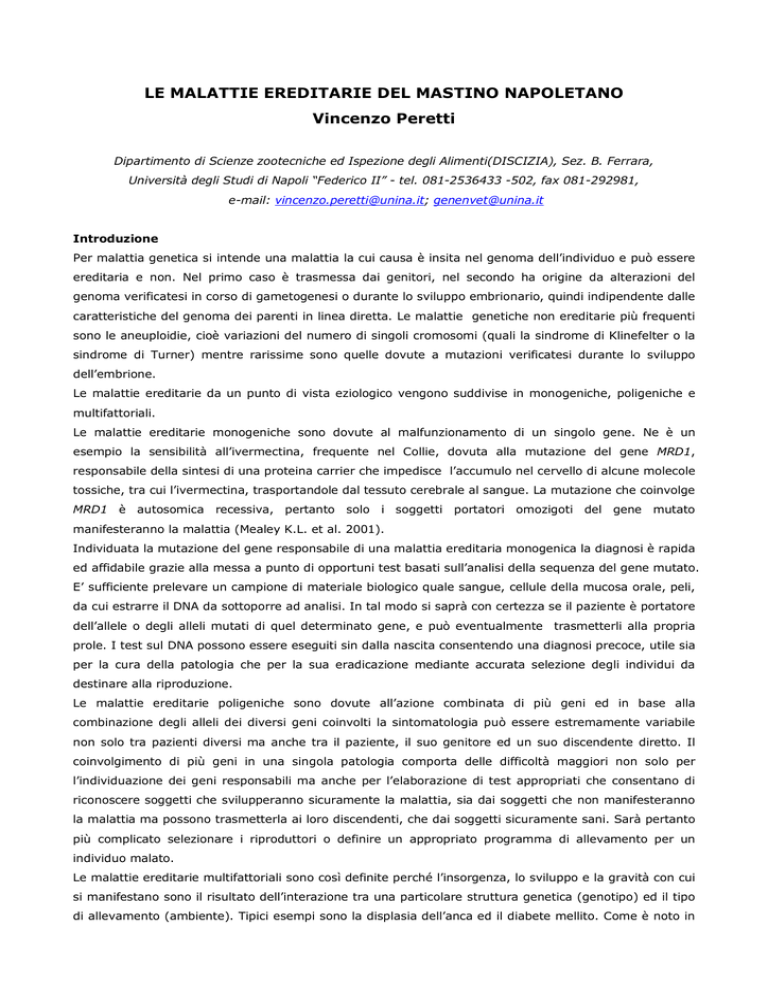
LE MALATTIE EREDITARIE DEL MASTINO NAPOLETANO
Vincenzo Peretti
Dipartimento di Scienze zootecniche ed Ispezione degli Alimenti(DISCIZIA), Sez. B. Ferrara,
Università degli Studi di Napoli “Federico II” - tel. 081-2536433 -502, fax 081-292981,
e-mail: [email protected]; [email protected]
Introduzione
Per malattia genetica si intende una malattia la cui causa è insita nel genoma dell’individuo e può essere
ereditaria e non. Nel primo caso è trasmessa dai genitori, nel secondo ha origine da alterazioni del
genoma verificatesi in corso di gametogenesi o durante lo sviluppo embrionario, quindi indipendente dalle
caratteristiche del genoma dei parenti in linea diretta. Le malattie genetiche non ereditarie più frequenti
sono le aneuploidie, cioè variazioni del numero di singoli cromosomi (quali la sindrome di Klinefelter o la
sindrome di Turner) mentre rarissime sono quelle dovute a mutazioni verificatesi durante lo sviluppo
dell’embrione.
Le malattie ereditarie da un punto di vista eziologico vengono suddivise in monogeniche, poligeniche e
multifattoriali.
Le malattie ereditarie monogeniche sono dovute al malfunzionamento di un singolo gene. Ne è un
esempio la sensibilità all’ivermectina, frequente nel Collie, dovuta alla mutazione del gene MRD1,
responsabile della sintesi di una proteina carrier che impedisce l’accumulo nel cervello di alcune molecole
tossiche, tra cui l’ivermectina, trasportandole dal tessuto cerebrale al sangue. La mutazione che coinvolge
MRD1 è autosomica recessiva, pertanto solo i soggetti portatori omozigoti del gene mutato
manifesteranno la malattia (Mealey K.L. et al. 2001).
Individuata la mutazione del gene responsabile di una malattia ereditaria monogenica la diagnosi è rapida
ed affidabile grazie alla messa a punto di opportuni test basati sull’analisi della sequenza del gene mutato.
E’ sufficiente prelevare un campione di materiale biologico quale sangue, cellule della mucosa orale, peli,
da cui estrarre il DNA da sottoporre ad analisi. In tal modo si saprà con certezza se il paziente è portatore
dell’allele o degli alleli mutati di quel determinato gene, e può eventualmente trasmetterli alla propria
prole. I test sul DNA possono essere eseguiti sin dalla nascita consentendo una diagnosi precoce, utile sia
per la cura della patologia che per la sua eradicazione mediante accurata selezione degli individui da
destinare alla riproduzione.
Le malattie ereditarie poligeniche sono dovute all’azione combinata di più geni ed in base alla
combinazione degli alleli dei diversi geni coinvolti la sintomatologia può essere estremamente variabile
non solo tra pazienti diversi ma anche tra il paziente, il suo genitore ed un suo discendente diretto. Il
coinvolgimento di più geni in una singola patologia comporta delle difficoltà maggiori non solo per
l’individuazione dei geni responsabili ma anche per l’elaborazione di test appropriati che consentano di
riconoscere soggetti che svilupperanno sicuramente la malattia, sia dai soggetti che non manifesteranno
la malattia ma possono trasmetterla ai loro discendenti, che dai soggetti sicuramente sani. Sarà pertanto
più complicato selezionare i riproduttori o definire un appropriato programma di allevamento per un
individuo malato.
Le malattie ereditarie multifattoriali sono così definite perché l’insorgenza, lo sviluppo e la gravità con cui
si manifestano sono il risultato dell’interazione tra una particolare struttura genetica (genotipo) ed il tipo
di allevamento (ambiente). Tipici esempi sono la displasia dell’anca ed il diabete mellito. Come è noto in
tali patologie, così come in tutte le malattie ereditarie multifattoriali, seguendo particolari criteri di
allevamento è possibile migliorare le condizioni cliniche del malato incidendo sull’evoluzione e la gravità
della patologia, tuttavia è altrettanto risaputo che è complicato individuare i soggetti a rischio e
selezionare in modo appropriato i riproduttori.
Invece nelle malattie ereditarie monogeniche e poligeniche è necessaria sempre e comunque la
somministrazione di farmaci (qualora esista una terapia appropriata) per tenere sotto controllo
l’evoluzione della patologia.
E’ importante precisare che la classificazione delle malattie ereditarie in monogeniche, poligeniche e
multifattoriali in taluni casi è una schematizzazione didattica temporanea poiché spesso con il progredire
delle ricerche si scopre che una malattia ritenuta monogenica può rivelarsi multifattoriale o viceversa.
Inoltre un altro aspetto di grande interesse è che la medesima patologia in diverse razze canine può
essere determinata da mutazioni differenti localizzate sullo stesso gene o addirittura da mutazioni
differenti localizzate su geni diversi.
Alcune malattie ereditarie riscontrate nel Mastino Napoletano
La displasia d’anca
E’ la deformazione dell’articolazione coxofemorale con conseguente instabilità della stessa; se non
controllata evolve in degenerazione dell’articolazione fino al blocco funzionale. Clinicamente l’animale
affetto da displasia d’anca presenta una zoppia che, con il progredire dei fenomeni degenerativi a carico
delle strutture ossee coinvolte, si aggraverà nel tempo.
E’ una malattia ereditaria a trasmissione autosomica recessiva, ad eziologia multifattoriale, genetica ed
ambientale, sebbene la prima abbia un peso maggiore nella patogenesi. Infatti molti studi confermano
che sono coinvolti più geni ciascuno dei quali regola lo sviluppo delle differenti strutture (cartilagine,
connettivo e muscoli) che costituiscono la regione dell'anca.
All’esame obiettivo particolare i soggetti malati presentano uno sviluppo delle masse muscolari
inadeguato rispetto all’impalcatura scheletrica ed è proprio l’incompetenza della muscolatura a mantenere
congruente l’articolazione che favorisce la lassità articolare, il progressivo allontanamento della testa del
femore dalla cavità acetabolare e la conseguente riduzione dell’area di contatto tra le superfici articolari.
Inevitabile sarà l’insorgenza di alterazioni cartilaginee, microfratture ossee e alterazioni del profilo
acetabolare e della testa femorale che rappresentano l’anticamera dell’artrosi.
Purtroppo ad oggi, le conoscenze acquisite sulla identificazione, localizzazione, funzionalità ed eventuali
mutazioni dei geni coinvolti non sono sufficienti per elaborare test genetici in grado di discriminare con
assoluta certezza i soggetti a rischio da quelli sani. Attualmente la selezione viene effettuata attraverso lo
studio della probabilità dell’insorgenza della patologia sulla base di indici genetici calcolati su uno studio
dei fenotipi (esami radiografici e clinici) degli individui appartenenti alla stessa famiglia.
La displasia del gomito
Consiste nell’anomalo sviluppo dell’articolazione del gomito responsabile nel tempo dell’insorgenza di
artrosi e successivo blocco funzionale. Le principali lesioni, determinanti instabilità ed incongruenza
articolare
che con
il tempo sono
responsabili della
insorgenza della
displasia
del gomito e
successivamente dell’artrosi, sono: la frammentazione del processo coronoideo mediale dell'ulna (FCP Fragmented Coronoid Process), l’incongruenza articolare (INC - Incongruity), l'osteocondrite dissecante
del comparto mediale del condilo omerale (OCD - Osteocondritis dissecans) e la mancata unione del
processo anconeo dell'ulna (UAP - Ununited Anconeal Process). Anche questa patologia è considerata ad
eziologia multifattoriale (genetica e ambiente), l’alimentazione e la tipologia di esercizio fisico giocano un
ruolo importante nella sua evoluzione, ma la componente genetica rimane di fondamentale importanza.
Infatti è una patologia frequente solo in alcune
razze e
solo la selezione consente di ridurne sia la
frequenza che la gravità. A tal proposito l’analisi delle radiografie del gomito fatte dal 1988 al 2006, in
Polonia, a cani di 90 diverse razze ha posto il Mastino Napoletano tra le razze più frequentemente colpite
da questa patologia (8,9% dei cani di tale razza presenta displasia dl gomito) (Narojek T., et al. 2008)
La displasia del gomito è una malattia di tipo poligenico e sino ad oggi non sono stati ancora individuati i
geni coinvolti. La diffusione di questa malattia è tale da aver indotto la costituzione di un’associazione
mondiale (International Elbow Working Group - IEWG - [email protected]) con lo scopo di definire linee guida
per l’eradicazione e di incoraggiare futuri studi sulle cause e cure innovative.
La cataratta
E’ la malattia oculare ereditaria di più frequente riscontro nei cani di razza ed è caratterizzata
dall’opacizzazione progressiva del cristallino di entrambi gli occhi con conseguente riduzione della vista
sino alla cecità. Può essere congenita, se presente già alla nascita, o acquisita, se si sviluppa durante il
corso della vita. Quest’ultima viene classificata in giovanile, se insorge prima del quarto anno di vita, o
tardiva, se insorge più tardi.
Analizzando la trasmissione ereditaria della cataratta in differenti razze canine è stato dimostrato che
nella maggior parte di esse è una malattia monogenica dovuta alla mutazione di un gene maggiore
recessivo. Tuttavia come è noto le modalità d’insorgenza della cataratta si differenziano nelle razze
canine predisposte, poiché differenti sono le mutazioni a carico del gene responsabile. In tutte le razze
colpite l’età di insorgenza della malattia è estremamente variabile pertanto è fondamentale testare il
prima possibile i soggetti che si intende destinare alla riproduzione.
La cardiomiopatia congenita
E’ il malfunzionamento del muscolo cardiaco non associato a malformazioni del cuore o delle sue valvole.
Esistono tre forme di cardiomiopatia: dilatativa, ipertrofica e restrittiva, quest’ultima mai descritta nel
cane. In generale risultano affetti cani delle razze grandi e giganti.
La miocardiopatia dilatativa è la forma di più frequente riscontro e pertanto la più studiata. Le modalità di
trasmissione variano a seconda della razza considerata, è autosomica dominante nel Boxer, X-linked
recessiva nell’Alano (Broschk e Distl, 2005), autosomica dominante a penetranza incompleta nel
Terranova (Wiersma et al. 2008). Condizione particolare è quella che si osserva nel cane d’acqua
portoghese in cui è presente una forma ad eredità autosomica recessiva, a comparsa molto precoce e con
morte in età compresa tra le 2 e le 32 settimane di vita (Werner et al., 2008). Nel Mastino Napoletano si
osserva una notevole precocità di insorgenza (9-24 mesi) dello scompenso cardiaco rispetto ad altre
razze (4-10 anni).
Tutto ciò indica che la patologia può derivare da mutazioni a carico di geni differenti e che pertanto ogni
razza riconosce modalità di trasmissione ed insorgenza variabili.
Individuare pertanto i geni e le mutazioni responsabili della patologia non è semplice, molti sono gli studi
svolti a tale scopo e tra i più recenti possiamo citare quello di Werner et al. (2008) che con una serie di
analisi del genoma del cane d’acqua portoghese ha potuto individuare una regione del CFA8 in cui molto
probabilmente sono localizzati i geni le cui mutazioni sono alla base della miocardiopatia dilatativa
presente in questa razza canina.
Atrofia Progressiva della Retina
Per atrofia progressiva della retina (PRA) si intende un’insieme di patologie ereditarie caratterizzate dalla
graduale degenerazione fino alla morte dei fotorecettori della retina, prima i bastoncelli e poi i coni, con
conseguente riduzione delle capacità visive culminante in cecità completa. Sebbene diagnosticata in più di
100 razze canine solo per la metà di queste è nota la causa genetica che le determina (Vilboux et al.
2008). L’età di insorgenza è molto variabile a seconda della razza considerata, nei Setter Irlandesi inizia a
25 giorni dalla nascita, mentre nel Segugio Finlandese l’età media d’insorgenza è di 4 anni. Anche la
modalità di trasmissione cambia essendo in alcuni casi autosomica recessiva ed in altri X-linked. La forte
eterogeneità inter-razziale, sia nell’età di insorgenza che nelle modalità di trasmissione ed evoluzione
della PRA, è legata al fatto che in ogni razza essa dipende da una diversa mutazione a carico di un
diverso gene. Nel Setter Irlandese è dovuta ad una mutazione puntiforme a carico dell’esone 21 del gene
PDE6B (Rod Cone Displasya Type I), nell’Alaskan Malamute (in cui viene anche chiamata Achromatopsia3) la mutazione causale è una delezione di un intero esone del gene CNGB3, mentre nel Siberian Husky e
nel Samoiedo è una delezione di 5 basi nel gene RPGR localizzato sul CFAX (definita come X-Linked
Progressive Retinal Atrophy 1 - XLPRA1). Ad oggi sono state caratterizzate 15 diverse mutazioni tutte
responsabili di PRA e, recentemente, Vilboux T. et al. (2008) hanno dimostrato nel Border Collie
l’esistenza di una nuova forma di PRA caratterizzata da insorgenza tardiva, mediamente 3 anni, e
trasmissione X-linked, non dovuta alle mutazioni del gene RPRG responsabili di XLPRA1 nel Samoiedo e
nel Siberian Husky e di XLPRA2 nel Mongrel.
Dalle analisi effettuate si evince che il gene mutato
responsabile di tale forma è localizzato sul CFAX, e studi futuri avranno lo scopo di identificare gene e
mutazione alla base della XLPRA3.
Altra interessante caratteristica di questa patologia è che talvolta anche in individui di una stessa razza e
con la stessa mutazione le caratteristiche cliniche, in termini di età di insorgenza, gravità e velocità del
decorso, risultano differenti. Guyon R. et al. (2007), incuriositi da tale aspetto, hanno creato una linea
genetica di cani in cui era presente la mutazione XLPRA1 al fine di stabilire se le differenze fenotipiche
nell’espressione clinica della malattia potessero essere attribuite all’azione di 6 geni che è risaputo
interagiscono con il gene RPGR. Purtroppo nessuno dei geni esaminati si è rivelato poter avere funzione
di modificatore nell’insorgenza della malattia, ma si spera che futuri studi riescano a mettere in luce
anche le basi genetiche responsabili di quest’altro interessantissimo aspetto della PRA, peraltro presente
anche nelle forme cliniche umane.
Per ognuna delle diverse mutazioni evidenziate alla base della PRA sono stati sviluppati test diagnostici
differenti in grado di differenziare i soggetti sani, e che pertanto potranno tranquillamente essere
destinati alla riproduzione dai portatori e dai soggetti che svilupperanno la malattia. E’ chiaro però che
variando a seconda della razza la mutazione responsabile di PRA, al fine di avere una corretta diagnosi, è
essenziale un corretto segnalamento.
Come controllare la diffusione delle malattie ereditarie
La prevenzione nelle malattie ereditarie è un elemento fondamentale e va effettuata in più momenti,
primo tra tutti nella scelta dei soggetti da destinare alla riproduzione. I riproduttori andranno testati per
tutte le malattie ereditarie tipiche della razza di appartenenza ed andranno ovviamente scartati sia i
soggetti positivi ai test genetici che i soggetti che alle visite cliniche presentano segni di patologie
ereditarie per le quali ancora non sono disponibili test o di patologie che si suppone siano ereditarie.
Per coloro che intendano acquistare cuccioli di razza è sempre bene informarsi su quali siano le
problematiche principali della razza prescelta e chiedere all’allevatore i pedigree dei genitori del cucciolo
che si intende acquistare.
Importante è poi sottoporre il cucciolo acquistato ai test genetici ed agli esami clinici necessari per
verificare sia il suo stato di salute generale sia la sua predisposizione ad eventuali malattie genetiche.
Il cane, tuttavia, non è un oggetto e molto spesso nonostante le predisposizioni a varie patologie, lo
sguardo di un cucciolo intenerisce il probando acquirente-proprietario!
Risulta importante allora seguire appropriati programmi di allevamento che consentano di rallentare, se
non di bloccare, la progressione della malattia e di migliorare la vita del nostro animale, nonché
sottoporlo a regolari controlli e chiedere consigli al proprio veterinario di fiducia sulle modalità di gestione
dell’animale.
Un cane cieco in seguito ad un’atrofia progressiva della retina ha difficoltà di movimento in ambienti
aperti ed a lui non familiari, ma nel proprio territorio si comporterà come un qualsiasi individuo
dall’ottima vista.
Bibliografia
1) Aleksiewicz, R., Budzińska, Z., Nowicki, M., Adamiak, Z., Lisiecka, B. (2008). Canine hip dysplasia of
selected breeds - Results obtained by two Polish clinics based on radiological examination conducted in
1997-2006. Polish Journal of Veterinary Sciences 11(2):139-142.
2) Broschk C., Distl O. (2005). Dilated cardiomyopathy (DCM) in dogs--pathological, clinical, diagnosis
and genetic aspects. Dtsch Tierarztl Wochenschr Oct;112(10):380-5.
3) Dekomien G., Runte M., Godde R., Epplen J.T. (2000). Generalized progressive retinal atrophy of
Sloughi dogs is due to an 8-bp insertion in exon 21 of the PDE6B gene. Cytogenet Cell Genet
90(3-
4):261-267.
4) Guyon R., Pearce-Kelling S.E., Zeiss C.J., Acland G.M., Aguirre G.D. (2007). Analysis of six candidate
genes as potential modifiers of disease expression in canine XLPRA1, a model for human X-linked retinitis
pigmentosa 3. Molecular Vision 13:1094-105.
5) Mealey K.L., Bentjen S.A., Gay J.M., Cantor G.H. (2001). Ivermectin sensitivity in collies is associated
with a deletion mutation of the mdr1 gene. Pharmacogenetics Nov 11(8):727-33.
6) Narojek, T., Fiszdon, K., Hanysz, E. (2008). Canine elbow dysplasia in different breeds. Bulletin of the
Veterinary Institute in Pulawy 52(1):169-173
7) Suber M.L., Pittler S.J., Qin N., Wright G.C., Holcombe V., Lee R.H., Craft C.M., Lolley R.N., Baehr W.,
Hurwitz R.L. (1993). Irish setter dogs affected with rod/cone dysplasia contain a nonsense mutation in
the rod cGMP phosphodiesterase β-subunit gene. Genetics 90, 3968-3972.
8) Vilboux T., Chaudieu G., Jeannin P., Delattre D., Hedan B., Bourgain C., Queney G.,
Galibert F.,
Thomas A., André C. (2008). Progressive Retinal Atrophy in the Border Collie: A new XLPRA. BMC
Veterinary Research 4:10.
9) Werner P., Raducha M.G., Prociuk U., Sleeper M.M., Van Winkle T.J., Henthorn P.S. (2008). A novel
locus for dilated cardiomyopathy maps to canine chromosome 8. Genomics 91, 517–521.
10) Wiersma A.C., Stabej P., Leegwater P.A.J., Van Oost B.A., Ollier W.E., Dukes-Mcewan J. (2008).
Evaluation of 15 Candidate Genes for Dilated Cardiomyopathy in the Newfoundland Dog. Journal of
Heredity 99(1):73–80.
HEREDITARY DISEASES IN NEAPOLITAN MASTIFF
Vincenzo Peretti
Department of Animal Science and Food Inspection (DISCIZIA), Sez. B. Ferrara,
University of Naples “Federico II”- ph. 081-2536433 -502, fax 081-292981,
e-mail: [email protected]; [email protected]
Introduction
Genetic disease is an illness condition the cause of which is embedded in the genome and it can be
inherited or not. In the first case it is handed down from the parents, in the second it depends on
genome alterations arisen during gamatogenesis or during embryo development, so that it is independent
of genome features of relatives in direct line. The most common non-hereditary genetic diseases are
aneuploidies, in which there is an extra or missing chromosome (such as in Klinefelter’s Syndrome and
Turner Syndrome) while extremely rare are those due to mutations arisen during embryo development.
Considering etiology hereditary diseases can be classified in monogenic, polygenic and multfactorial.
Monogenic hereditary diseases are caused by a non-functional single gene. An example is Ivermectin
Sensitivity, a condition frequent in Collie, due to a mutation in MRD1 gene, that encodes for a carrier
protein that prevents the build-up of some toxic molecules in the brain, including ivermectin, carrying
them from brain tissue to blood. The mutation in MRD1 is autosomal recessive, and only the omozygous
carriers of the mutated gene show symptoms (Mealey K.L. et al. 2001).
Once the gene mutation that cause an hereditary monogenic disease is discovered the diagnosis is fast
and safe thanks to the development of tests based on the sequence of the mutated gene. It is sufficient
to take a little sample of biological material, like blood, oral mucous cells, hair, for the extraction of DNA
to analyse. In this way it is possible to ensure if the patient is or not a carrier of the mutated allele (or
alleles) of that particular gene, and if he is able to transmit them to offspring. DNA tests can be
performed at birth allowing a precocious diagnosis, useful either for disease management in the patient
and for disease eradication through a careful selection of the animal for breeding.
Polygenic hereditary diseases are due to the combined action of different genes and depending on allele
combinations of the genes involved the symptomatology is extremely variable not only among patients
but also between the patient and its direct relatives. The involvement of more genes in the same
pathology means more difficulties not only for the identification of the genes involved but also for the
development of
tests capable to identify subjects that will develop the illness, subjects that will not
develop the disease but will transmit it to the offspring and healthy subjects. So it will be more difficult to
select breeding animals or to set a breeding plan for a sick subject.
Multifactorial hereditary diseases are called in this way because onset, development and seriousness
depend on the interaction between a particular genetic structure (genotype) and breeding management
(environment). Typical examples are hip dysplasia and diabetes mellitus. As it is well known, for these
diseases, as all multifactorial diseases, with particular management criteria it is possible to improve the
clinical conditions of the patient influencing the seriousness and the development of the pathology, but it
is well known the difficulty in the identification of the risk subjects and in the selection of aimals for
mating.
As regard monogenic and polygenic diseases to control the progress of the pathology it is always
necessary to make the therapy (if one exists).
It is important to highlight that the classification of hereditary diseases in monogenic, polygenic and
multifactorial is temporary since with the progress of research it often turns out that a monogenic disease
is a multifactorial one and vice versa. Moreover, another aspect of great interest is that the same disease
in different dog breeds can be linked to different mutations located in the same gene or in different genes.
Some Neapolitan Mastiff hereditary diseases.
Hip dysplasia
Hip dysplasia is an abnormal formation of the hip socket which is associated with instability. If not
controlled the joint degenerates to the function block. Clinically an animal with hip dysplasia shows
lamness that, as the bone scaffold degeneration goes on and on, will be more and more serious.
It is an hereditary disease with autosomal recessive inheritance, multifactorial etiology, with genetic and
environmental components, but the first one (genetic) has more weight in the pathogenesis. In fact many
studies show that they are involved a lot of genes each of which plays a role in the development of the
structures forming hip joint.
During clinical examination the patients show an inadequate muscular mass development for the bone
scaffold, muscles incompetence to keep congruent the joint promotes the articulation laxity, and the
gradual shift away from the head of the femur and the acetabulum of the pelvis and the consequent
reduction in the area of the contact of the joint surfaces. It is certain the onset of cartilage deformations,
bone microfractures and alteration of the acetabulum profile and of the head of the femur that are the
beginning step for the arthritis.
Unfortunately the actual knowledge about identification, localization, functionality and mutations of the
genes involved are insufficient to develop genetic tools to discriminate with absolute certainty between
healthy and risk animals. Nowadays selection is based on the study of the probability of occurrence of the
dysplasia according to genetic indexes calculated on the study of the phenotypes (radiograph and clinical
examination) of patient’s relatives.
Elbow dysplasia
It consists of the abnormal development of elbow joint, responsible for arthritis development and function
block. The main lesions, that cause instability and articulation incongruity that, time after time, cause
elbow dysplasia and arthritis, are: Fractured Medial Coronoid Process (FMCP), Incongruity (INC),
Osteocondritis dissecans (OCD) e Ununited Anconeal Process (UAP ).
Also this pathology is considered with multiple etiology (genetic and environmental components), feeding
and exercises play a main role for his evolution, but genetic component is still of great importance. In
fact this pathology is frequent only in some breeds and only selection can reduce both frequency and
seriousness.
In this regard the study of the radiographs of the elbow made at dogs of 90 different breeds from 1988
to 2006, in Poland, has placed the Neapolitan Mastiff between breed most commonly affected by this
pathology (8,9% of dogs of this breed shows Elbow dysplasia) (Narojek T., et al. 2008).
Elbow dysplasia is a polygenic disease and as yet genes involved in this pathology are not been identified.
The spreading of this pathology is such that it has been founded a World Association (International Elbow
Working Group - IEWG - [email protected]) with the aim of setting the guidelines for the eradication and the
aim of encouraging studies about causes and innovative therapy.
Cataracts
It is the most common eye inherited disease that affect bred dogs and it is characterized by the
progressive crystalline lens clouding in both eyes with gradual vision loss to blindness. It can be
congenital, when present at birth, or acquired, when it develops during life. The last one can be classified
in juvenile, if the onset is before the fourth year of life, and late, if the onset is after the fourth year of
life.
Analysing cataracts inheritance in different dog breeds it has been show that it is often a monogenic
disease due to the mutation of a recessive major gene. Even so cataracts onset conditions are very
different in the predisposed breeds, because different are the mutations in the gene. As the onset age it
varies between breeds so it is fundamental to test as soon as possible the animals to be used for mating.
Congenital cardiomyopathy
It is the condition in which the heart muscle is malfunctioning despite the absence of heart and its valves
malformations. There are three forms: dilated, hypertrophic and restrictive cardiomyopathy. The last one
never diagnosed in dog. Typically they are affected large and giant sized dog breeds.
Dilated cardiomyopathy (DCM) is the most common and therefore most studied form. Inheritance modes
are different by breeds, it is autosomal dominant in Boxer, X-linked recessive in Great Dane (Broschk e
Distl, 2005), autosomal dominant with incomplete penetrance in Newfoundland dog (Wiersma et al.
2008). Very particular is the Portuguese Water Dog breed since it has a form with recessive autosomal
inheritance, with very early onset and death between 2 and 32 weeks of age (Werner et al., 2008).
As regard Neapolitan Mastiff DMC is characterized by early onset (9-24 months of age) of heart failure if
compared with other breeds (4-10 years of age).
This means that the pathology can be caused by different mutations in different genes and so every
breed has is particular type of inheritance and onset.
Therefore to identify genes and mutations involved in DCM is not easy, there are a lot of studies with this
aim and among the most recent we could cite the one of Werner et al. (2008) that with some analysis of
Portuguese Water Dog genome identified a region in CFA8 in which they could be located genes the
mutations of which are the cause of DCM in this breed.
Progressive Retinal Atrophy (PRA)
It consists of a set of inherited diseases characterized by the gradual degeneration until death of the
photoreceptors of the retina, initially rods and then cones, with the gradual loss of vision and finally the
total blindness. It has been diagnosed in more than 100 dog breeds but only for the half of these it is
known the genetic basis (Vilboux et al. 2008). Age at onset differs between breeds, In Irish Setter breed
it starts at 25 days of age, while in Finnish Hound breed median age at onset is 4 years. As regard
inheritance features they differs being in some breeds autosomal recessive and in other breeds X-linked.
The strong inter-breed heterogeneity, as regard the age at onset, the inheritance way and the features of
evolution, is linked to the fact that for every breed there is a different mutation in a different gene. In the
Irish Setter it is due to a point mutation in the exon 21 of the gene PDE6B (Rod Cone Displasya Type I),
in the Alaskan Malamute (Achromatopsia-3) the mutation is an exon deletion in the gene CNGB3, while in
the Siberian Husky and in Samoyed is a 5bp deletion in the gene RPGR located on CFAX (also named XLinked Progressive Retinal Atrophy 1 - XLPRA1). To this days they have been characterized 15 different
mutations for PRA and, recently Vilboux T. et al. (2008) have proved a new form of PRA affecting the
Border Collie and characterized by late onset, median age being 3 years, and X-linked inheritance, but
the causing mutation not located in RPRG gene, that causes XLPRA1 of Samoyed and Siberian Husky and
XLPRA2 of Mongrel. According to the analysis the mutated gene responsible for this form is located on
CFAX, and future studies will identify the gene and the mutations that are the cause of XLPRA3.
Another main feature of this pathology is that in dogs of the same breed and with the same mutation the
clinical features differs, for example age at onset, seriousness of the disease and the speed of the
evolution. Guyon R. et al. (2007), intrigued by this aspect, created a genetic dog lineage with XLPRA1
mutation to verify if phenotypic differences as regard disease clinical expression could be linked to the
action of 6 genes that are known to interact with RPGR gene. Unfortunately none of the examined genes
was discovered to be a modifier function in the onset of PRA, but it is hoped that future studies will
discover genetic basis of this very interesting aspect of PRA that is typical also in human PRA.
For every different mutation discovered for PRA they have been developed different tests capable to
differenziate healthy dogs, that can be used for mating, from carriers from the animals that will develop
the disease. However it is clear that being different the mutation causing PRA for every breed, to have
the correct diagnosis it is very important a correct animal data collection.
How control the spreading of Inherited diseases.
Prevention of inherited diseases is fundamental and it is to be carried out in different steps, first of all in
the choice of the animals for breeding. They must be tested for all inherited diseases that are common in
their breed and they must be discarded both animals testing positive and animals showing clinical signs
of inherited diseases for which tests haven’t still developed, or showing clinical signs of diseases that are
supposed to be inherited.
As regard the purchase of puppies bred it is always best to inquire about the main problems of the
chosen breed and to ask the breeder for the pedigrees of the puppies’ parents to buy.
Then it is important to control the purchased puppy with genetic tests and clinical examinations to verify
his general health condition and his predisposition for genetic diseases.
However a dog isn’t an object and often, despite the predisposition for a lot of pathologies, a puppy stare
touches the probable buyer-propertier!
So it is important to perform appropriate breeding programs useful to slow down, or to stop, the
progression of the disease and to improve life conditions of the pet, and to submit it to regular checks
and to ask the own vet for suggestions about its management.
A blind dog affected by progressive retinal atrophy has difficulties in moving in unfamiliar open spaces,
but in its territory he behaves like a normal dog by the excellent view.
Bibliografia
1)
Aleksiewicz, R., Budzińska, Z., Nowicki, M., Adamiak, Z., Lisiecka, B. (2008). Canine hip dysplasia
of selected breeds - Results obtained by two Polish clinics based on radiological examination conducted in
1997-2006. Polish Journal of Veterinary Sciences 11(2):139-142.
2)
Broschk C., Distl O. (2005). Dilated cardiomyopathy (DCM) in dogs--pathological, clinical,
diagnosis and genetic aspects. Dtsch Tierarztl Wochenschr Oct;112(10):380-5.
3)
Dekomien G., Runte M., Godde R., Epplen J.T. (2000). Generalized progressive retinal atrophy of
Sloughi dogs is due to an 8-bp insertion in exon 21 of the PDE6B gene. Cytogenet Cell Genet
90(3-
4):261-267.
4)
Guyon R., Pearce-Kelling S.E., Zeiss C.J., Acland G.M., Aguirre G.D. (2007). Analysis of six
candidate genes as potential modifiers of disease expression in canine XLPRA1, a model for human Xlinked retinitis pigmentosa 3. Molecular Vision 13:1094-105.
5)
Mealey K.L., Bentjen S.A., Gay J.M., Cantor G.H. (2001). Ivermectin sensitivity in collies is
associated with a deletion mutation of the mdr1 gene. Pharmacogenetics Nov 11(8):727-33.
6)
Narojek, T., Fiszdon, K., Hanysz, E. (2008). Canine elbow dysplasia in different breeds. Bulletin of
the Veterinary Institute in Pulawy 52(1):169-173
7)
Suber M.L., Pittler S.J., Qin N., Wright G.C., Holcombe V., Lee R.H., Craft C.M., Lolley R.N., Baehr
W., Hurwitz R.L. (1993). Irish setter dogs affected with rod/cone dysplasia contain a nonsense mutation
in the rod cGMP phosphodiesterase β-subunit gene. Genetics 90, 3968-3972.
8)
Vilboux T., Chaudieu G., Jeannin P., Delattre D., Hedan B., Bourgain C., Queney G., Galibert F.,
Thomas A., André C. (2008). Progressive Retinal Atrophy in the Border Collie: A new XLPRA. BMC
Veterinary Research 4:10.
9)
Werner P., Raducha M.G., Prociuk U., Sleeper M.M., Van Winkle T.J., Henthorn P.S. (2008). A
novel locus for dilated cardiomyopathy maps to canine chromosome 8. Genomics 91, 517–521.
10)
Wiersma A.C., Stabej P., Leegwater P.A.J., Van Oost B.A., Ollier W.E., Dukes-Mcewan J. (2008).
Evaluation of 15 Candidate Genes for Dilated Cardiomyopathy in the Newfoundland Dog. Journal of
Heredity 99(1):73–80.





